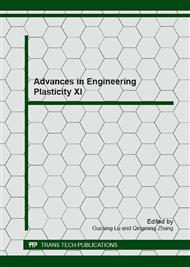p.509
p.514
p.518
p.522
p.526
p.530
p.534
p.539
p.543
Possible Schemes to Reduce Nose Blunting of High-Speed Projectile into Concrete
Abstract:
High-speed projectile usually has significantly nose blunting which may decrease performance of projectile. Since the peeling of molten surface layer is the primary cause of mass loss of projectile, the projectile made of refractory material may reduce nose blunting. Two possible schemes to distribute refractory material in projectile are suggested in the present manuscript, i.e. layering refractory material outside the projectile nose surface and using material with gradient melting heat to make projectile nose. Based on one numerical model previously constructed by our team, both schemes are able to reduce nose blunting and enhance performance of projectile.
Info:
Periodical:
Pages:
526-529
Citation:
Online since:
January 2013
Authors:
Keywords:
Price:
Сopyright:
© 2013 Trans Tech Publications Ltd. All Rights Reserved
Share:
Citation:


